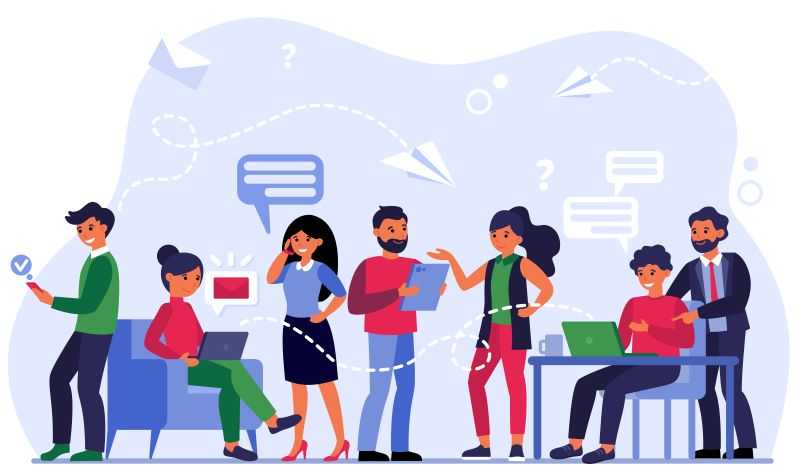Understanding Communication Process and Its Types

Communication is the act of transferring thoughts, information, emotions, and ideas from one person to another using gestures, voice, symbols, signs, and expressions. It involves three essential elements: the sender, the receiver, and the channel (medium) through which the communication takes place.
Communication Process
Process of Communication is a continuous process that consists of the following elements:
- Sender: The sender, also known as the communicator, generates and initiates the message to be conveyed to the receiver.
- Message: The message is the idea, information, view, fact, or feeling that is generated by the sender and intended to be communicated.
- Encoding: The message generated by the sender is encoded symbolically, such as through words, pictures, or gestures, before it is conveyed.
- Media: The media refers to the means through which the encoded message is transmitted. It can include oral or written methods, such as telephone, internet, post, fax, or email. The choice of medium is determined by the sender.

Types of Communication
1. Verbal Communication:
This type of communication involves the use of spoken or written words to express and convey messages. It is commonly used during presentations, video conferences, phone calls, meetings, and conversations.
Oral Communication
Communication that occurs through spoken words, conversations, speeches, or telephonic exchanges.
Written Communication
Communication that takes place through written words, such as hand-written or typed documents, letters, newspapers, or books.
2. Non-Verbal Communication
Non-verbal communication occurs without the use of spoken or written language. It involves the use of signs, symbols, colors, gestures, body language, or facial expressions.
Nonverbal communication helps convey information through body language, gestures, and facial expressions, providing insights into thoughts and feelings.
Formal and Informal Communication: Communication within an organization can be categorized as formal or informal.
Formal Communication:
This refers to communication that occurs through official channels within an organization. It can be oral or written, and it is recorded and maintained by the organization.
Informal Communication:
Informal communication spreads quickly and is difficult to trace back to its source. It often leads to rumors but can be helpful in quickly disseminating information.
Characteristics of Communication
Some important characteristics of communication include:
- Involvement of at Least Two Persons: Communication involves a sender and a receiver, both essential for the process to occur.
- Two-Way Process: Communication is not just about sending and receiving messages; it requires mutual understanding between the sender and the receiver.
- Purposeful Communication: Communication must convey a message, whether it is an order, instruction, report, or suggestion. The purpose is to create understanding and elicit a response.
- Various Forms of Communication: Communication can take different forms, such as verbal or written, formal or informal, depending on the context.
- Wide Scope: Communication is crucial in all human relationships and is essential at all levels of management within organizations.
- Dynamic Process: Communication is influenced by the mood and thinking of both the sender and the receiver, and the acceptance of a message depends on the receiver's sensory perception at that time.

Types of Communication Networks
The different types of communication networks operating in formal organisation are discussed below:
- Linear Chain: This facilitates a flow of communication from a superior to a subordinate, spanning different levels within an organization via a single chain.
- Wheel: In this network, the superior acts as the central hub of the wheel, with all underlings communicating solely through him or her, with no allowance for direct communication among themselves.
- Circular: In this network, communication flows at a slower pace and moves in a circular pattern. Each individual can comfortably communicate with their adjacent peers.
- Inverted V: This network allows a subordinate to communicate not only with their immediate superior but also with the superior's superior. However, communication in this case tends to be limited.
Pros of Formal Communication
Formal communication has several benefits:
- Authority Preservation: It upholds the superiority of a higher-ranking individual over their subordinates.
- Structured Information Flow: Information follows a defined pathway, ensuring systematic flow.
- Confidentiality: It allows for the maintenance of secrecy.
- Traceable Information Source: With this communication type, the origin of each piece of information can be easily identified.
Cons of Formal Communication
Formal communication also has several disadvantages:
- Increased Workload: It amplifies the workload of various managers, as all communications must traverse a specific channel.
- Information Distortion: Sometimes, the distance between the sender and the receiver is so great that information passes through many intermediaries, leading to distortion by the time it reaches the receiver.
- Lack of Personal Touch: Formal communication often lacks personal warmth and involvement.
Pros of Informal Communication
Informal communication offers several advantages:
- Quick and Spontaneous: Messages flow faster and more spontaneously in this type of communication.
- Unrestricted Environment: Informal communication takes place in an unrestricted environment where there's no pressure on any officer. It can flow in any direction and extent.
- Promotes Social Relations: It aids in fostering better human relations by providing a platform for employees at social gatherings, both within and outside the organization.
- Supplementary: Informal communication supplements formal communication. Certain matters, such as the workers' attitudes and opinions about management plans and policies, which are challenging to communicate through formal channels, can be easily conveyed through informal communication.

Cons of Informal Communication
However, informal communication also has its drawbacks:
- Absence of Accountability: In formal communication, responsibility for misinformation can be pinpointed, but this is not possible in informal communication.
- Unreliable Information: Most of the information received through this type of communication is unreliable, making it unsuitable as a basis for significant decisions.
- Potential Information Leakage: It may result in the leakage of crucial information, which could be detrimental to the organization.
I hope you have been able to discover something new by reading through this well-research article, however, don't forget to add your opinion in the comment box below
Author Bio
For over 4 years, Saalim has worked as a branding, digital marketing, and SEO expert. He has been assisting with website design, SEO strategy, content marketing, and user experience improvements. He publishes on a variety of topics and is a contributing writer to a number of high-quality blogs and websites.
Article Comments
No Comments!
At present there are zero comments on this article.
Why not be the first to make a comment?
Similar Articles
Sponsor
Search Articles
Experts Column
Latest Articles
Featured Articles
Most Popular Articles












